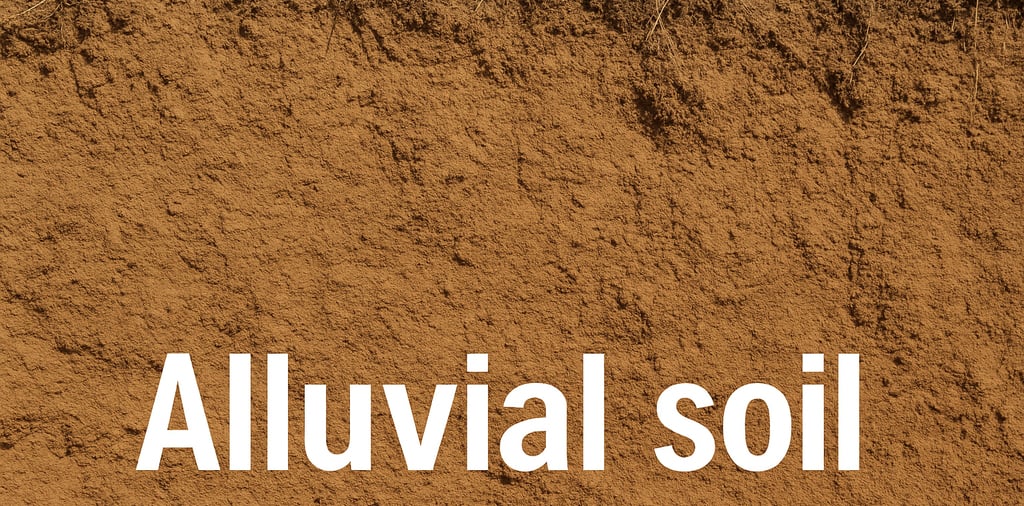Alluvial Soil: Importance, Advantages, and Applications
Alluvial soil is a type of soil that is formed through the deposition of sediments by rivers, streams, and floodwaters. This process occurs over time as running water erodes rocks and other materials upstream and carries them downstream, where they eventually settle in low-lying areas such as riverbanks, deltas, and floodplains.
SOIL HEALTH & FERTILITY
8/18/20257 min read


What is Alluvial Soil?
Alluvial soil is a type of soil that is formed through the deposition of sediments by rivers, streams, and floodwaters. This process occurs over time as running water erodes rocks and other materials upstream and carries them downstream, where they eventually settle in low-lying areas such as riverbanks, deltas, and floodplains. The composition of alluvial soil can vary significantly depending on the geographical location, the nature of the sediments that are transported, and the climatic conditions of the area.
One defining characteristic of alluvial soil is its texture, which can range from sandy to clayey, depending on the proportions of the different particle sizes present. This variability in texture impacts the soil's overall structure and influences its agricultural suitability. Alluvial soils generally boast a high level of fertility, making them essential for productive farming. The nutrient content is often rich, as sediments brought in by water movement can include organic matter and minerals that enhance soil fertility.
Moreover, alluvial soils have excellent water-retention capacity due to their particle size and composition. This characteristic enables them to hold moisture effectively, making them favorable for various crops. While alluvial soils are predominantly found in areas adjacent to rivers and water bodies, they can also be influenced by environmental factors, such as surrounding vegetation and climate variations, which can change their properties over time. Understanding the formation and characteristics of alluvial soil is crucial, especially for agricultural practices, as it directly impacts crop yields and sustainable land management.
The Importance of Alluvial Soil in Agriculture
Alluvial soil, characterized by its nutrient-rich composition and fine-textured structure, plays a vital role in agricultural practices around the globe. Formed by the sedimentation of rivers and streams, this type of soil is renowned for its high fertility levels, making it a cornerstone for successful crop cultivation. One of the key aspects of alluvial soil is its ability to hold moisture while providing adequate drainage, creating an optimal environment for plant growth. This combination not only enhances the vitality of crops but also promotes healthier yields, essential for sustainable agriculture.
The rich mineral content of alluvial soils, which often includes essential nutrients such as nitrogen, phosphorus, and potassium, supports rapid plant growth and overall productivity. Farmers who utilize alluvial soil frequently observe increased crop yields, enabling them to meet the demands of growing populations. Furthermore, the natural organic matter found within this soil contributes to improved soil structure, which is beneficial for water infiltration and root development. Consequently, alluvial soils significantly contribute to the sustainability of farming practices by reducing the need for excessive chemical fertilizers and pesticides, thus promoting ecological balance.
In addition to enhancing individual farm productivity, alluvial soils support diverse farming systems, from traditional agriculture to modern agro-ecological practices. Their adaptability allows for a wide range of crops, including grains, vegetables, and fruits. This diversity also enhances food security, making alluvial soil integral to feeding millions of people worldwide. As agriculture faces increasing challenges from climate change and urbanization, understanding and prioritizing the conservation of alluvial soils is essential for sustaining global food systems and ensuring long-term agricultural resilience.
Advantages of Alluvial Soil for Ecosystems and Biodiversity
Alluvial soils play a crucial role in supporting diverse ecosystems and fostering biodiversity. These fertile soils are often found in floodplains, river valleys, and deltas, where they are deposited by the action of flowing water. Their rich nutrient content and optimal drainage qualities make them highly conducive to the growth of a wide variety of plant species. This diverse plant life, in turn, forms the foundation for complex food webs, supporting both herbivorous and carnivorous wildlife. As a result, areas with alluvial soils often host a high density of both flora and fauna, promoting rich biodiversity.
Moreover, alluvial soils contribute significantly to habitat creation. They can support different vegetation zones, from grasslands to forests, thereby providing essential habitats for numerous animal species. The presence of these diverse plant communities aids in stabilizing habitats, reducing soil erosion, and providing shelter and food sources for various organisms. For instance, wetland areas formed in alluvial regions often serve as critical breeding and feeding grounds for aquatic birds and amphibians.
In addition to habitat creation, alluvial soils offer vital ecosystem services that are essential for environmental sustainability. Their ability to filter water helps maintain groundwater quality and reduces sedimentation in aquatic ecosystems. This filtration process is particularly important for maintaining the health of rivers and lakes, supporting aquatic biodiversity. Furthermore, alluvial soils play a role in carbon sequestration, capturing atmospheric carbon dioxide and mitigating climate change effects. By storing carbon, they contribute to the overall health of the ecosystem, making them invaluable in the quest for sustainable land management and biodiversity preservation.
Applications of Alluvial Soil Beyond Agriculture
Alluvial soil, primarily recognized for its fertility and capacity to support agricultural endeavors, has a range of applications extending into non-agricultural fields. One significant area is construction, where alluvial soil is utilized as a critical component in building materials. Its granular structure and compactness provide an ideal foundation for various types of structures, facilitating robust construction practices. As cities expand, the incorporation of alluvial soil into urban development projects can enhance stability and durability, ensuring long-lasting infrastructures.
In addition to its role in construction, alluvial soil finds extensive use in landscaping. The soil’s rich nutrient content and excellent drainage properties make it particularly valuable for enhancing gardens, parks, and public spaces. Landscapers and horticulturists often choose alluvial soil for planting ornamental plants, trees, and shrubs because it fosters a healthy growth environment. The ability to retain moisture while allowing excess drainage supports diverse vegetation, thereby improving aesthetic appearances and promoting biodiversity in urban areas.
Moreover, alluvial soil plays a vital role in environmental restoration projects, particularly in combating soil erosion and restoring degraded lands. Its rich organic matter can be particularly beneficial in rehabilitating sites that have suffered from erosion due to water runoff or deforestation. By using alluvial soil to create protective layers, environmental engineers can effectively mitigate further soil degradation while improving land use in compromised areas. This ecological restoration not only aids in preserving the environment but also enhances the productivity of land that may no longer support viable agricultural activities.
Overall, alluvial soil's applications beyond agriculture underscore its significance in construction, landscaping, and environmental initiatives. As society continues to navigate urban development and environmental challenges, the versatile nature of alluvial soil will remain pivotal in fulfilling these diverse needs.
Challenges and Threats to Alluvial Soil
Alluvial soil, renowned for its fertility and critical role in agriculture, faces a multitude of challenges that threaten its integrity and sustainability. One of the most pressing issues is pollution, which can originate from agricultural runoff, industrial discharges, and urban waste. Fertilizers, pesticides, and heavy metals can contaminate alluvial soils, which not only diminishes their nutrient content but also affects the broader ecosystem. The hazardous substances infiltrate the soil profile, impacting soil organisms and reducing overall soil health.
Erosion is another significant threat to alluvial soil. This process, exacerbated by deforestation, overgrazing, and poor land management practices, results in the loss of topsoil, the most fertile layer that supports plant growth. The natural structure of alluvial soil can be disturbed when vegetation cover is removed, leading to increased susceptibility to wind and water erosion. As soil is eroded, agricultural productivity declines, requiring farmers to rely more on chemical inputs for crop yields, creating a vicious cycle of soil degradation.
Furthermore, unsustainable farming practices, such as monocropping and excessive tillage, have long-lasting implications for alluvial soil. These practices lead to compaction and a decline in biodiversity, which are vital for maintaining soil health. The frequent use of heavy machinery can strip away nutrients and disrupt the natural microbiome that supports plant growth. Continuous cultivation without adequate rotation can deplete essential nutrients necessary for crops, requiring even greater inputs to achieve desired yields.
These threats highlight the need for immediate conservation efforts to protect alluvial soils. Implementing sustainable practices, such as crop rotation, cover cropping, and reduced tillage systems, can enhance soil health, mitigate erosion, and decrease pollution. Addressing these challenges is crucial for ensuring the longevity and productivity of alluvial soils, thereby supporting food security and environmental sustainability.
Sustainable Management Practices for Alluvial Soil
Sustainable management practices play a critical role in enhancing the health and productivity of alluvial soils. These soils, characterized by their rich nutrient content, are often under threat from erosion, salinization, and improper agricultural practices. To mitigate these challenges, farmers and soil managers can implement various sustainable techniques. One effective method is crop rotation, where different crops are planted in succession on the same land. This technique helps in maintaining soil fertility, disrupting pest cycles, and reducing the likelihood of diseases. By alternating deep-rooted and shallow-rooted crops, nutrients are efficiently used, which promotes long-term health of alluvial soil.
Another beneficial practice is cover cropping, which involves planting specific crops during the off-season. Cover crops, such as legumes and grasses, serve multiple purposes. They protect the soil from erosion, improve organic matter content, and enhance soil microbial activity. Additionally, when cover crops decompose, they contribute essential nutrients back into the soil, benefiting subsequent cultivation. This is particularly significant in alluvial regions, where the soil may be subject to excessive leaching.
Agroforestry is yet another sustainable practice worth considering. This approach integrates trees and shrubs with traditional crops, creating a diverse ecosystem that supports soil health. The roots of trees stabilize the soil, reducing erosion, while leaf litter contributes organic matter. The shade provided by these trees can also reduce soil temperature fluctuations, promoting a more stable environment for crops. Furthermore, involving local communities in sustainable soil management efforts ensures a cooperative approach, fostering awareness and shared responsibility towards alluvial soil preservation. By emphasizing these sustainable practices, we can enhance the resilience and productivity of alluvial soils for future generations.
Conclusion: The Future of Alluvial Soil
In summary, alluvial soil plays a crucial role in fostering agricultural productivity, supporting diverse ecosystems, and enhancing human livelihoods across various regions. The fertility of alluvial soils, enriched by nutrient deposition from rivers and streams, has made them essential for cereal cultivation, horticulture, and other types of agriculture. This soil type not only facilitates high crop yields but also sustains the livelihoods of millions of farmers reliant on its abundant resources.
Moreover, the ecological functions of alluvial soils are paramount. These soils contribute to biodiversity by providing habitats for countless organisms ranging from microorganisms to larger wildlife. Additionally, they play a significant role in water retention and sediment control, ultimately influencing local hydrology and reducing flood risks. As climate change and human activities increasingly threaten these valuable land resources, it is imperative to adopt sustainable management practices to protect the integrity of alluvial soils.
Furthermore, the adoption of protective measures is vital for ensuring the continued productivity of alluvial soils. Practices such as crop rotation, sustainable irrigation, and soil conservation techniques can help mitigate erosion, maintain soil fertility, and promote resilience against environmental changes. Stakeholders, including policymakers, farmers, and environmentalists, must collaborate to establish policies that prioritize the sustainable use and conservation of alluvial soils, thereby securing their benefits for future generations.
As we advance, the interplay between agriculture and conservation becomes ever more critical. Recognizing the importance of alluvial soil and addressing the challenges it faces will be essential in safeguarding not only food security but also ecological balance. Continuing research, public awareness, and community action will be key components in ensuring that alluvial soils remain a viable and productive resource for all inhabitants of the Earth.


"Boosting Crop Growth With Nature's Power"
Contact Us:
E Mail: support@frosil.com
Customer Care: +91 8329592991
FROSIL © 2025. All rights reserved.


'Frosil' is a fertilizer manufacturer committed to enhancing soil health and crop yields. We provide high-quality, eco-friendly products that support sustainable agriculture and help farmers achieve optimal results.
Registered Office: Gat No.96, Near Krushnai Hospital, Tandali. Tal- Shirur, Dist- Pune.
